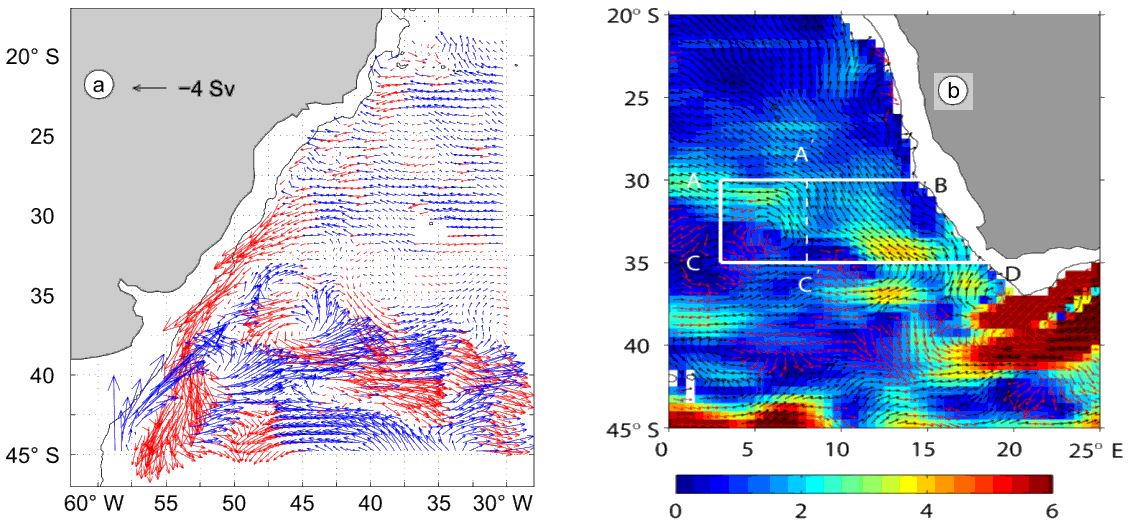
Benguela Current & Brazil Current
|
|
|
Benguela Current Brazil Current |
|
|
Transport of upper ocean boundary current in sub-tropical South Atlantic
from Argo and Altimetry
The Benguela Current forms the eastern limb of the subtropical gyre in the South Atlantic and transports a blend of relatively fresh and cool Atlantic water and relatively warm and salty Indian Ocean water northwestward. Therefore, it plays an important role not only for the local freshwater and heat budgets but for the overall meridional heat and freshwater transport in the South Atlantic. Historically, the Benguela Current region is relatively data sparse, especially with respect to long-term velocity observations. A new three-dimensional data set of the horizontal velocity in the upper 2000 m that covers the years 1993 to 2015 is used to analyze the variability in the Benguela Current. This data set was derived using observations from Argo floats, satellite sea surface height, and wind fields. Since Argo floats do not cover regions shallower than 1000 m, the data set has gaps inshore. The main features of the horizontal circulation observed in this data set are in good agreement with those from earlier studies based on limited observations. Therefore, it can be used for a more detailed study of the flow pattern as well as the variability in the circulation in this region. It is found that the mean meridional transport in the upper 800 m between the continental shelf of Africa and 3 ° E, decreases from 23 ± 3 Sv (1 Sv = 10 6 m 3 s−1 ) at 31°S to 11 ± 3 Sv at 28°S. In terms of variability, the 23-year long time series at 30 and 35°S reveals phases with large energy densities at periods of 3 to 7 months, which can be attributed to the occurrence of Agulhas rings in this region. The prevalence of Agulhas rings is also behind the fact that the energy density at 35°S at the annual period is smaller than at 30°S because the former latitude is closer to Agulhas Retroflection and therefore more likely to be impacted by the Agulhas rings. In agreement with this, the energy density associated with mesoscale variability at 30°S is weaker than at 35°S. With respect to the forcing, the Sverdrup balance and the observed transport at 30°S exhibit a strong correlation of 0.7. No significant correlation between these parameters is found at 35°S.
The Brazil Current transports from observations and the Hybrid Coordinate Model (HYCOM) model are analyzed to improve our understanding of the current’s structure and variability. A time series of the observed transport is derived from a three-dimensional field of the velocity in the South Atlantic covering the years 1993 to 2015 (hereinafter called Argo & SSH). The mean transports of the Brazil Current increases from 3.8 ± 2.2 Sv (1 Sv = 10 6 m 3 s−1 ) at 25°S to 13.9 ± 2.6 Sv at 32°S, which corresponds to a mean slope of 1.4 ± 0.4 Sv per degree. Transport estimates derived from HYCOM fields are somewhat higher (5.2 ± 2.7 and 18.7 ± 7.1 Sv at 25 and 32°S, respectively) than those from Argo & SSH, but these differences are small when compared with the standard deviations. Overall, the observed latitude dependence of the transport of the Brazil Current is in agreement with the wind-driven circulation in the super gyre of the subtropical South Atlantic. A mean annual cycle with highest (lowest) transports in austral summer (winter) is found to exist at selected latitudes (24, 35, and 38°S). The significance of this signal shrinks with increasing latitude (both in Argo & SSH and HYCOM), mainly due to mesoscale and interannual variability. Both Argo & SSH, as well as HYCOM, reveal interannual variability at 24 and 35°S that results in relatively large power at periods of 2 years or more in wavelet spectra. It is found that the interannual variability at 24°S is correlated with the South Atlantic Subtropical Dipole Mode (SASD), the Southern Annular Mode (SAM), and the Niño 3.4 index. Similarly, correlations between SAM and the Brazil Current transport are also found at 35°S. Further investigation of the variability reveals that the first and second mode of a coupled empirical orthogonal function of the meridional transport and the sea level pressure explain 36 and 15 % of the covariance, respectively. Overall, the results indicate that SAM, SASD, and El Niño–Southern Oscillation have an influence on the transport of the Brazil Current.
